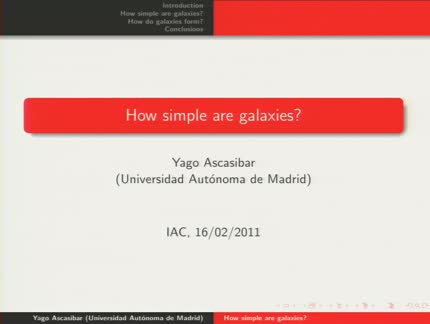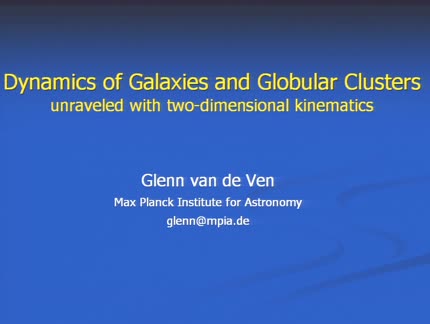Found 219 talks archived in Galaxies

Abstract
Galaxies are arguably complex systems. However, they also display many scaling relations between their physical properties, hinting that it might be possible to summarize all this complexity within a few phenomenological parameters. In this talk, we will first address the question of how many parameters are indeed necessary in order to describe a galaxy, and then discuss some of them in detail, aiming towards a self-consistent, cartoon (yet remarkably accurate) picture of galaxy formation and evolution.
Abstract
This lecture will address recent progress in modeling the emergence of cosmic structure at high redshifts. Also new insights gained from numerical simulations into the processes relevant for star formation are presented. Rapid magnetic field growth in galaxies and the important role of proto-stellar outflows regulating star formation up to pc scales are particularly highlighted.

Abstract
In this talk I will present the first complete 12CO J=3-2 map of M81, observed as part of the Nearby Galaxies Legacy Survey. We have detected nine regions of significant CO emission located at different positions within the spiral arms, and confirmed that the global CO emission in the galaxy is low. Using a new Hα map obtained with the Isaac Newton Telescope and archival data I will discuss a series of topics including the correlation between the molecular gas and star forming regions, the CO (3-2)/(1-0) line ratio, and the amount of hydrogen produced in photo-dissociation regions near the locations where CO J=3-2 was detected.

Abstract
Massive stars dominate the light output of entire galaxies, with luminosities in excess of 105 L⊙. This makes them powerful probes with which to study a range of astrophysical phenomena. In this talk I will review the recent results of our group, in which we have been able to shed new light on the recent star-forming history of our Galaxy, and the nature of supernova progenitors. I will also discuss our latest project, which is to use massive stars as tracers of extra-galactic star-forming histories out to distances of 10 Mpc and beyond.

Abstract
Early-type dwarfs (dEs) are by far the most abundant galaxy population in nearby clusters. Whether these objects are primordial, or recent end-products of the different physical mechanisms that can transform galaxies once they enter these high-density environments, is still a matter of debate. Here we present a novel approach to test the latter scenario by comparing the properties of the globular cluster systems of dEs and their potential progenitors with simple predictions from gravitational and hydrodynamical interactions. Current data in the literature do not favour violent mechanisms, but gentle processes with long timescales or that took place at the early stages of their formation.
Abstract
Massive (≥ 1011 M⊙) galaxies at high redshift (z ≥ 1.5) remain mysterious objects. Their extremely small sizes (effective radii of 1-2 kpc) make them as dense as modern globular clusters. It is thought that a highly dissipational merger is needed to create such compact type of galaxies. We will discuss this issue, along with state-of-the-art morphological and kinematic observations of these objects. In the present day Universe massive galaxies show large sizes, and harbor old and metal-rich stellar populations. In order to explore their development, we present near-IR IFU observations with SINFONI@VLT for ten massive galaxies at z=1.4 solely selected by their high stellar mass which allow us to retrieve velocity dispersions, kinematic maps and dynamical masses. We joined this with data and works coming from the GOODS NICMOS Survey, the largest sample of massive galaxies (80 objects) with high-resolution imaging at high redshift (1.7 < z < 3) acquired to date. As a result, we show how their morphology changes possibly through elusive minor merging.
Abstract
The distribution of matter in galaxies of different luminosities and Hubble types, as inferred from observations, plays an important role in cosmology, extragalactic astrophysics, astroparticle physics, as well as in a number of issues in high-energy astrophysics, galactic astronomy, star formation and evolution and general relativity. Not withstanding the general successes of the ΛCDM model in explaining the structure and evolution of the universe, there is a growing conviction that the structural properties of the dark and luminous components in galaxies hold important clues about the nature of dark matter and about the processes that are responsible for galaxy formation. This talk is part of an international initiative known as "Dark Matter Awareness Week".The overall purpose of this event is to increase the awareness of the phenomenology of the mass discrepancy phenomenon in galaxies amongst the many scientists currently working with a theoretical, observational, experimental and simulation approach on issues involving dark matter or its alternatives. The content of the talk will be at the level of a journal club talk with an important dose of review.

Abstract
In this talk, I will cover our contribution to the study of extremely red galaxy (ERG) populations presenting a multi-wavelength analysis of these objects, selected in the GOODS-South/Chandra Deep Field South field. By using all the photometric (from X-rays to radio) and spectroscopic information available on large deep samples of extremely red objects (EROs, 645 sources), infrared EROs (IEROs, 294 sources) and distant red galaxies (DRGs, 350 sources), we derive redshift distributions, identify AGN powered and star-formation powered galaxies (based on X-ray properties and a new IR AGN diagnostic developed by us), and, using the radio observations of this field, estimate robust (AGN- and dust-unbiased) star formation rate densities (SFRD) for these populations. Applying a redshift separation (1 ≤ z < 2 and 2 ≤ z ≤ 3) we find a significant rise (a factor of 1.5 — 3) of SFRD for EROs and DRGs toward high-z, while none is observed for IEROs. As expected, we find a significant overlap between the ERG populations, and investigate the properties of "pure" (galaxies that conform to only one of the three considered ERG criteria) and "combined" (galaxies conforming to all three criteria) sub-populations. We find ERG sub-populations with no AGN activity and intense star-formation rates. With average values of ~180 M⊙/yr at 2 ≤ z < 3, they reasonably contribute to the global star-formation rate density, reaching a > 20% level. Strong AGN behaviour is not observed in the ERG population, with AGN only increasing the average radio luminosity of ERGs by 10 — 20%. However, AGN are frequently found (in up to 27% of the ERG population), and would increase the SFRD estimate by over 100%. Thus, and while the contribution of SF processes to the radio luminosity in galaxies with AGN remains uncertain, a comprehensive identification of AGN in these populations is necessary to obtain meaningful results. The dust content to each population is also derived by correlating UV and Radio SFRs, giving a higher obscuration for more active SF sources. Also, know to be amongst the most massive galaxies in the high-z universe, I will show that ERGs may constitute up to 60% of the total mass in the universe at 1 ≤ z ≤ 3. Finally, preliminary and promising results are presented on the morphologies of ERGs (CAS and Gini/M20 parameters) based on the v1.9 ACS GOODS-S images.
Abstract
Recent observations of the rotation curve of M31 show a rise of the outer part that cannot be understood in terms of standard dark matter models or perturbations of the galactic disc by M31's satellites. In this talk, we show a possible explanation of this dynamical feature based on the influence of the magnetic field within the thin disc. We have considered standard mass models for the luminous mass distribution, a Navarro-Frenk-White model to describe the dark halo, and we have added up the contribution to the rotation curve of a magnetic field in the disc. We have found a significant improvement of the fit in the outer part when magnetic effects are considered. Our best-fit requires a field strength of ~ 4μG which is compatible with the observations of the magnetic fields in M31.

Abstract
Two-dimensional stellar kinematics obtained with the integral-field spectrograph SAURON allow the classification of early-type galaxies into 'slow' and 'fast' rotators, different from their morphological classification into ellipticals and lenticulars. Most fast rotators, including lenticular as well as many elliptical galaxies, are consistent with oblate axisymmetric disk-like systems. On the other hand, the slow-rotator ellipticals show clear deviations from axisymmetry, which can be modeled with our extension of Schwarzschild's orbit superposition method to triaxial geometry. Besides galaxies, I show that Schwarzschild's method can also be used to model in detail globular clusters such as ω Cen and M15. The recovered internal orbital structure of ω Cen reveals besides a signature of tidal interaction, also a central stellar disk, supporting its origin as the nucleus of a stripped dwarf galaxy. The formally best-fit Schwarzschild model for M15 includes an intermediate-mass black hole, but we cannot exclude a model in which dark remnants make up the dark mass in the collapsed core.
Upcoming talks
- Runaway O and Be stars found using Gaia DR3, new stellar bow shocks and search for binariesMar Carretero CastrilloTuesday April 30, 2024 - 12:30 GMT+1 (Aula)
- Detecting GWs in the muHz: natural and artificial satellites as GW detectorsProf. Diego BlasThursday May 2, 2024 - 10:30 GMT+1 (Aula)









